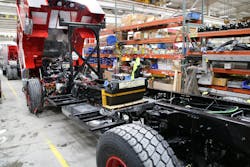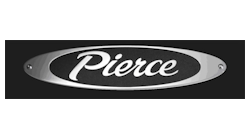When it Comes to Apparatus Emmissions Regulations, the Worst Is Over
It’s been more than 10 years since emissions restrictions were implemented for fire apparatus. Experts say the most consequential changes affecting them are now in their rearview mirror, but there are a few bumps in the road ahead.
One could argue that it doesn’t make much sense to regulate vehicles meant to extinguish fires producing multiple times more noxious emissions than an apparatus could produce in its service life. The reality is that the Environmental Protection Agency (EPA) and lawmakers chose to regulate all vehicles—emergency, over-the-road and even military vehicles.
Politics aside, regulations for fuel consumption, emissions and the reduction of carbon footprints have been part of doing business for apparatus makers and users alike since 2007.
Spartan standpoint
“The first wave of what I would call significant regulation that affected the cost and price of apparatus was the diesel particulate filter,” said Wesley Chestnut, manager of product safety and compliance for Spartan Motors in Charlotte, MI.
Chestnut said some apparatus manufacturers were challenged by the new emission requirements as were some engine makers. Some of the engine builders dropped out of the fire market all together, he said.
“There were a few hiccups,” Chestnut said. “There was a big learning curve for the engine manufacturers and some struggled more than others.”
The next big hurdle for engine and apparatus manufacturers was the introduction of selective catalytic reduction (SCR), and emission control technology systems that used diesel exhaust fluid (DEF).
Chestnut said SCR came into the fire service in 2010 and caused a significant price increase in fire apparatus, but he believes the industry and the regulations have “stabilized.”
“I don’t think you’ll see drastic swings one way or the other,” Chestnut said. “There will be price increases, just because of raw stock cost increases, but nothing big related to emissions.”
Following along a timeline, Chestnut said the changes to the rules from 2010 to the present have been “less significant” focusing on engine controls and reducing the carbon footprint by looking at internal changes to the engine and even exploring the rolling resistance of tires. Even transmission performance and the aerodynamics of vehicles have been under the microscope as the EPA tries to reduce the carbon footprint for vocational vehicles, a category of which fire apparatus is considered, Chestnut said. So far, the compliance rules amount to more than 1,100 pages, he added.
The next batch of changes is due in 2021, when apparatus manufactures will be asked to continue looking at rolling resistance and air-conditioning systems, Chestnut said. He further explained that by looking at the number of connections, fittings and potential spots for leaks, the EPA can certify air-conditioning systems. Refrigerants used in air-conditioning systems can be harmful to the environment if they are released into the atmosphere.
Chestnut acknowledged some fire departments have had issues with SCR and DEF systems, especially the early systems.
“If owners are having trouble with regeneration or DEF issues, they need to call the manufacturer,” he said. He added that manufacturers and rule makers have been developing a database of information and problems between each phase of regulations and will use the information to make adjustments.
While departments might have a two-year bumper-to-bumper warranty on apparatus, some of the emission control systems and components have a five-year warranty, Chestnut said. Users should work with the makers to understand which components are still covered, even though the overall apparatus is out of warranty.
“The bottom line is you need to stay in contact with your manufacturer,” Chestnut said. “You’ve got to work with the vehicle manufacturer.”
Pierce perspective
John Schultz, director of pumper and custom chassis products for Pierce Manufacturing, Appleton, WI, also believes that the ruckus around emissions regulation has “settled down a bit.”
“Overall, it’s come a long way from the 2007 DEF regulations and the 2010 SCR implementation,” Schultz said. “The overall acceptance is better and the reliability is better.”
Schultz said manufacturers are working to make the emissions control systems more robust and efficient and, as such, problems that were experienced years ago are becoming less frequent.
Recently, Cummins, one of the largest providers of engines for fire apparatus, has improved its SCR system to be handled by one “can” in the exhaust system rather than two as previously required. Schultz said that improvement is good for fire apparatus builders who don’t have to reserve as much space when designing apparatus bodies.
It also creates improved ash holding capability and improves serviceability, Schultz said.
Engine manufacturers have also been working on the speed in which the different electronic components can communicate as well as improving the DEF consumption, Schultz said.
Pierce is currently the only manufacturer that offers Detroit Diesel engines and Schultz said that product offering has been going well and changes in that offering have been “fairly quiet.”
Schultz added that come 2020, regulators are expected to have new rules to reduce greenhouse gases that will go into effect in 2021 affecting the overall rolling resistance of apparatus. “And that leads back to fuel efficiencies,” he said.
As the fire service has learned to live with all the emission control equipment and requirements, Schultz said apparatus manufacturers have also learned to adapt as well.
“It’s not going away,” he said. “It’s time to embrace it and understand it.”
Schultz said as the SCR and DEF requirements mature and are accepted, apparatus manufacturers can now focus on things like drain-line bleeders for pumps, wheel chock placement and body design and cabinet placements to accommodate the emissions equipment.
“We are having less and less conversation about what it is and how it is different,” Shultz said. “Now, we have conversations about optimization of those systems. We talk about things like the location of the DEF tank, the size of the DEF tank, a different kind of DEF tank and how to minimize the frequency of spills.”
Schultz added that engine and apparatus makers can now focus on making emissions equipment smaller, more robust and serviceable.
Truck builders now have all the technology in place and working, so they are now “able to take a breather,” step back and focus on refinement, he said.
“Firefighters need to understand that vehicles need to regenerate and they need to fit that into their day-to-day lives,” Schultz said. He added that doing the required regeneration and maintenance is far better than ignoring warning lights and indicators.
“When the regen light illuminates, it’s not something you can ignore,” he said, noting that ignoring lights can lead to expensive repairs to emissions systems.
Schultz said the regulations on the horizon are far less burdensome and less costly, but important to the overall operation of apparatus.
“At the moment, everything is stabilized,” Schultz said. “All the big stuff is done.”








